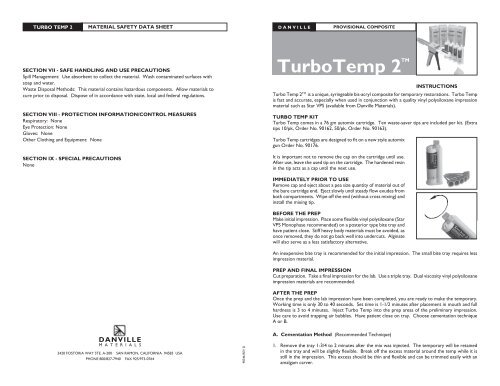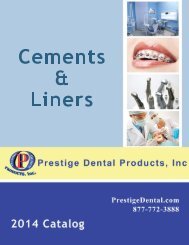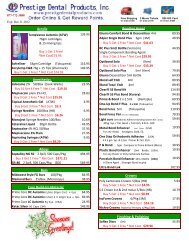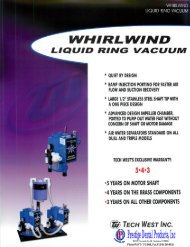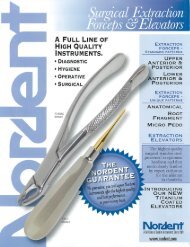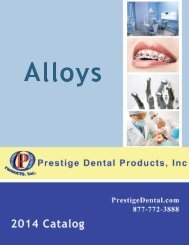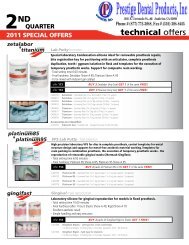Turbo Temp 2 - MSDS.pdf - Danville Materials
Turbo Temp 2 - MSDS.pdf - Danville Materials
Turbo Temp 2 - MSDS.pdf - Danville Materials
- No tags were found...
Create successful ePaper yourself
Turn your PDF publications into a flip-book with our unique Google optimized e-Paper software.
TURBO TEMP 2material safety data sheetD A N V I L L Eprovisional compositeSECTION VII - Safe Handling and Use PrecautionsSpill Management: Use absorbent to collect the material. Wash contaminated surfaces withsoap and water.Waste Disposal Methods: This material contains hazardous components. Allow materials tocure prior to disposal. Dispose of in accordance with state, local and federal regulations.SECTION VIII - Protection Information/Control MeasuresRespiratory: NoneEye Protection: NoneGloves: NoneOther Clothing and Equipment: NoneSECTION ix - Special PrecautionsNoneturbo<strong>Temp</strong> 2 TMINSTRUCTIONS<strong>Turbo</strong> <strong>Temp</strong> 2 TM is a unique, syringeable bis-acryl composite for temporary restorations. <strong>Turbo</strong> <strong>Temp</strong>is fast and accurate, especially when used in conjunction with a quality vinyl polysiloxane impressionmaterial such as Star VPS (available from <strong>Danville</strong> <strong>Materials</strong>).<strong>Turbo</strong> <strong>Temp</strong> Kit<strong>Turbo</strong> <strong>Temp</strong> comes in a 76 gm automix cartridge. Ten waste-saver tips are included per kit. (Extratips 10/pk, Order No. 90162, 50/pk, Order No. 90163).<strong>Turbo</strong> <strong>Temp</strong> cartridges are designed to fit on a new style automixgun Order No. 90176.It is important not to remove the cap on the cartridge until use.After use, leave the used tip on the cartridge. The hardened resinin the tip acts as a cap until the next use.Immediately Prior to UseRemove cap and eject about a pea size quantity of material out ofthe bare cartridge end. Eject slowly until steady flow exudes fromboth compartments. Wipe off the end (without cross mixing) andinstall the mixing tip.Before the PrepMake initial impression. Place some flexible vinyl polysiloxane (StarVPS Monophase recommended) on a posterior type bite tray andhave patient close. Stiff heavy body materials must be avoided, asonce removed, they do not go back well into undercuts. Alginatewill also serve as a less satisfactory alternative.An inexpensive bite tray is recommended for the initial impression. The small bite tray requires lessimpression material.Prep and Final ImpressionCut preparation. Take a final impression for the lab. Use a triple tray. Dual viscosity vinyl polysiloxaneimpression materials are recommended.After the PrepOnce the prep and the lab impression have been completed, you are ready to make the temporary.Working time is only 30 to 40 seconds. Set time is 1-1/2 minutes after placement in mouth and fullhardness is 3 to 4 minutes. Inject <strong>Turbo</strong> <strong>Temp</strong> into the prep areas of the preliminary impression.Use care to avoid trapping air bubbles. Have patient close on tray. Choose cementation techniqueA or B.D A N V I L L EM A T E R I A L S3420 fostoria way ste. A-200 San Ramon, California 94583 USAPhone 800/827-7940 Fax 925/973-076490346 REV DA. Cementation Method (Recommended Technique)1. Remove the tray 1-3/4 to 2 minutes after the mix was injected. The temporary will be retainedin the tray and will be slightly flexible. Break off the excess material around the temp while it isstill in the impression. This excess should be thin and flexible and can be trimmed easily with anamalgam carver.
TURBO TEMP 2 PROVISIONAL COMPOSITE TURBO TEMP 2 material safety data sheet2. Immediately reset the temp in the mouth and wait 1 or 2 more minutes for the completion of cure.3. Remove again, wait 4-5 minutes, and pop the temp out of impression.4. Trim margins with a diamond (it is now rigid).5. Cement in place, using a non-eugenol temporary cement.B. Non-Cementation Method1. Leave <strong>Turbo</strong> <strong>Temp</strong> in the mouth during the initial insertion for 2 ½ minutes. It will shrink to fit.It is recommended to cut an escape route in the facial surface of the impression. This will allowexcess <strong>Turbo</strong> <strong>Temp</strong> to escape, thereby reducing flashing.2. Remove impression from mouth; the temporary should remain in the mouth.3. Trim excess with the scalpel blade or a diamond bur if necessary.Note: Some non-cemented <strong>Turbo</strong> <strong>Temp</strong> restorations may turn dark after two weeks. To avoid this,either place permanent restoration within two weeks or cement the temporary restoration.<strong>Turbo</strong>temp 2 bridge fabrication:Three units is the recommended maximum span. To add strength the proximals of posteriors, theconnector areas should be modified to add bulk, prior to taking the preliminary impression. In theposterior, both buccal and lingual can be modified. In the anterior, most of the modification would bedone on the lingual to preserve esthetics. The preferred block-out material is Ultradent Blue Bolckout,but soft wax can also be used.Reinforcement can also be used in addition:Take the preliminary impression. Then place a piece of RibBond or some other fibers, from mesial todistal, using cured flowable composite to hold it on preps. The entire piece of reinforcement shouldbe infused with flowable composite. A figure 8 configuration might be considered. No bonding is usedso that the reinforcement will be retrievable with the temporary restoration. In the usual manner,form the <strong>Turbo</strong>temp 2 over the reinforcement. Do not disturb the oxygen inhibited outer layer onthe flowable so the <strong>Turbo</strong>temp 2 will adhere directly to it.Trouble Shooting• When starting with a new cartridge, discard the first pea size amount dispensed through the mixingtip to ensure even mixing.• Do not remove the mixing tip after each use. Wait until ready to use it again, then install newtip. This will prevent catalyst contamination possibly resulting in a plug.• Mount the mixing tip in proper alignment. Note that the tips are notched to indicate the properalignment on the cartridge. By forcing the tip, it can be mounted backwards, resulting in non-settingmixes. (The two sides of the mixing tip have different size bores.)• A slightly gummy air inhibited layer will remain on the hardened surface of the temporary. Thislayer allows bubble and margin defects to be minimized by directly bonding with a flowable compositesuch as StarFlow. The layer is easily removed with ethyl alcohol.• Exposure to temperatures below 74 0 F will extend the setting time of <strong>Turbo</strong> <strong>Temp</strong>. Set times arebased on room temperature material. Refrigeration greatly retards set times.• Normally there is no need for occlusal adjustments if vinyl polysiloxane is used.• Before placing a new mix tip, extrude a small amount of material to insure both sides are flowing.Waste a pea size amount of material immediately before use to insure a full mix.90346 REV DMaterial Safety DataSECTION 1 - Product IdentificaTIONCompany Name: <strong>Danville</strong> <strong>Materials</strong>3420 Fostoria Way Suite A-200San Ramon, CA 94583Phone (800) 827-7940Fax: (925) 973-0764Prepared: December 21, 2010SECTION III - Physical DataVapor Pressure: NegligibleVapor Density: >1Evaporation Rate: 1Appearance and Odor: Tooth colored paste, slight odorSECTION IV - Fire and ExplosionFlash Point: >100 O CExtinguishing Media: Carbon dioxide, foam, dry chemicalSpecial Fire Fighting Procedures: NoneFlammable Limits: NDUnusual Fire and Explosion Hazards: Polymerizes upon heating.SECTION V - Reactivity DataStable (x) Unstable ( )Conditions to Avoid: Heat in excess of 25 O C, direct sunlight or intense light.Incompatibility: Free radical initiators, oxidizing agentsHazardous Decomposition Products: Acrylic smokeHazardous Polymerization: May occur ( ) Will not occur (x)<strong>MSDS</strong> No. TT01SECTION II - Hazardous Ingredients of Mixtures OSHA ACGIHCAS # % WGT PEL TLV LD50Hazardous ComponentMultifunctional methacrylatesMalonylurea derivativeSilica fillerPolyvinyl esters30-40Trace45-505-10NDNDNDNDNDNDNDNDNDNDNDNDSECTION VI - Health Hazards and First Aid ProceduresPrimary Routes of Exposure: Skin, ingestionSigns of Exposure: Severe skin or eye irritation, redness or burning sensation.Ingestion may cause nausea.Medical Conditions Generally Aggravated by Exposure: Allergies to methacrylates.Carcinogens: None known.First Aid Procedures: For Skin - Wash off infected area with soap and water. For Ingestion -Seek medical advise, carry container with label and <strong>MSDS</strong>. For Eyes - Rinse immediately withplenty of water and consult physician.


